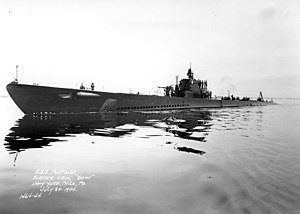USS Porpoise (SS-172)
Appearance
 | |
| History | |
|---|---|
| Builder | Portsmouth Naval Shipyard, Kittery, Maine[1] |
| Laid down | 27 October 1933[1] |
| Launched | 20 June 1935[1] |
| Commissioned | 15 August 1935[1] |
| Decommissioned | 15 November 1945[1] |
| Recommissioned | 8 May 1947 |
| Stricken | 13 August 1956[1] |
| Fate | Sold for scrap 14 May 1957[1] |
| General characteristics | |
| Class and type | |
| Displacement | 1,310 long tons (1,330 t) standard, surfaced,[2] 1,934 long tons (1,965 t) submerged[2] |
| Length | 283 ft 0 in (86.26 m) (waterline),[9] 301 ft 0 in (91.74 m)[2] (overall)[10] |
| Beam | 24 ft 11+3⁄4 in (7.614 m)[2] |
| Draft | 13 ft 10 in (4.22 m)[2] |
| Propulsion |
|
| Speed | 19 kn (35 km/h) surfaced,[2] 8 kn (15 km/h) submerged[2] |
| Range | 6,000 nmi (11,000 km) at 10 kn (19 km/h),[2] 22,000 nmi (41,000 km) @ 8 kn (15 km/h) with fuel in the main ballast tanks,[2] (bunkerage 93,129 US gallons (352,530 L) maximum, 89,945 US gallons (340,480 L) typical, 1944)[3] |
| Endurance | 10 hours @ 5 kn (9.3 km/h), 36 hours at minimum speed submerged[2] |
| Test depth | 250 ft (76 m)[2] |
| Complement | 5 officers, 9 chief petty officers, 42 enlisted (1944)[3] |
| Armament | 6 × machineguns[10] |
USS Porpoise (SS–172), the fifth
her class
of submarines.
Construction and commissioning
Porpoise was
laid down at the Portsmouth Naval Shipyard in Kittery, Maine, on 27 October 1933. She was launched on 20 June 1935, sponsored by Miss Eva Croft, and commissioned on 15 August 1935, Lieutenant Commander Stuart S. Murray
in command.
Service history
Inter-War Period
After shakedown, Porpoise transited the
Mare Island Navy Yard. In January 1938, she returned to Pearl Harbor for fleet exercises, and on 19 November 1939 got underway for Manila
to join the Asiatic Fleet. From December 1939-December 1941, she was engaged in various exercises with Submarines, Asiatic Fleet.
World War II
At the outbreak of the war with Japan with the japanese attack on Pearl Harbor on 7 December 1941, Porpoise, commanded by
Java
.
Conducting her second war patrol in the
Fremantle, Western Australia
. Then, with the ultimate destination of Pearl Harbor, she returned to the Netherlands East Indies for her third war patrol, which lasted from 26 April to 17 June 1942. She made one unsuccessful attack on a cargo ship and rescued five airmen off the enemy held island of Ju before heading out across the Pacific.
After a major overhaul at Mare Island, Porpoise departed Pearl Harbor for her fourth war patrol - from 30 November 1942 to 15 January 1943 - off the coast of
Honshū, Japan. On 1 January 1943, she sank Renzan Maru, then set course for Midway where she completed the patrol. Her fifth war patrol - which lasted from 6 February to 15 April 1943 - off Jaluit Atoll
, was highlighted by the sinking of Koa Maru on 4 April.
After refit at Pearl Harbor, Porpoise sailed on her sixth patrol - which lasted from 20 June to 28 July 1943 - performing reconnaissance of Taroa Island and in the Marshall Islands. Scoring hits on two cargo ships early in her patrol, she then sank Mikage Maru No. 20 on 19 July 1943 before returning to Pearl Harbor.
Due to leaky
United States Naval Reserve personnel in the Houston, Texas, area. Stricken from the Naval Vessel Register on 13 August 1956, she was sold for scrap to Southern Scrap Material Company, Ltd., of New Orleans, Louisiana
, on 14 May 1957.
Awards
- Asiatic-Pacific Campaign Medal with five battle stars for World War IIservice
References
Citations
- ^ ISBN 1-55750-263-3.
- ^ a b c d e f g h i j k l m U.S. Submarines Through 1945 pp. 305–311
- ^ a b c Alden, p.58.
- ^ Alden, John D., Commander, USN (retired). The Fleet Submarine in the U.S. Navy (Annapolis, MD: Naval Institute Press, 1979), p.210.
- ^ a b c Alden, p.210.
- ^ ISBN 0-313-26202-0.
- ^ U.S. Submarines Through 1945 pp.261–263
- ^ Alden, p.211.
- ^ Lenton, H. T. American Submarines (New York: Doubleday, 1973), p.39.
- ^ a b Lenton, p.39.
- ^ Hinman & Campbell, p. 158.
 This article incorporates text from the public domain Dictionary of American Naval Fighting Ships. The entry can be found here.
This article incorporates text from the public domain Dictionary of American Naval Fighting Ships. The entry can be found here.
Bibliography
- ^
